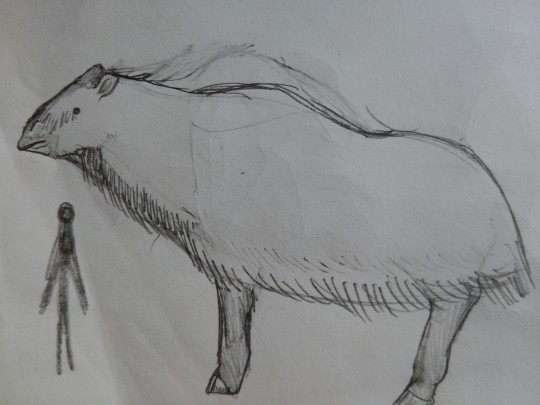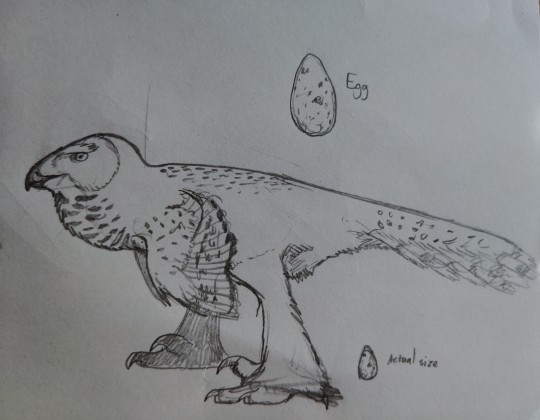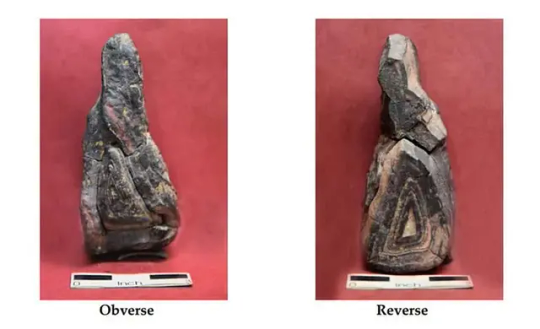#*ybp
Explore tagged Tumblr posts
Text

16 notes
·
View notes
Text

The Girl of Molzbach
Bronze Age, Hesse, Germany
Age 21 c.3,300 ybp
1 note
·
View note
Text
Project Dato: Within the Snow

Temporal Range: Late Pliocene – present (2.5 Mya - Present)
Domain: Eukaryota
Kingdom: Animalia
Phylum: Chordata
Class: Mammalia
Order: Artiodactyla
Family: Giraffidae
Subfamily: Palaeotraginae
Tribe: Yukitragini
Genus: Yukitragus
Species: Y. primigenius
Ancestor: Miocene species of Palaeotragus
The woolly giraffe (Yukitragus primigenius) is a species of large okapi-like giraffid native to the border tundra between North Moira and Tengoku.
These 9-ft tall behemoths are more heavily built and larger than their closest relatives, the deer giraffes of the genus Shikazarafa. This is due to a combination of Bergmann's rule, which dictates that animals living in colder environments are larger than their relatives in other habitats, and Allen's rule, which dictates that animals in such environments have thicker limbs than their counterparts.
Due to the cold environment, their tongues are pale in color; this is because they don't need to protect their tongues from UV. Woolly giraffes feed primarily on the leaves of woody plants, though their necks are shorter than those of giraffine and bohlinine giraffes, so the plants in question are low growing. Woolly giraffes breed somewhere in August, and give birth next year in June or July when food is most abundant.

While healthy adult woolly have very few predators, the same cannot be said for calves, who are preyed upon by the snow guivre, a species of cercornithean maniraptoran in the clade Onychocarnaria.
Temporal Range: Middle Pleistocene – present (400,000–0 YBP)
Domain: Eukaryota
Kingdom: Animalia
Phylum: Chordata
Clade: Dinosauria
Clade: Saurischia
Clade: Theropoda
Clade: Avialae
Clade: Cercornithes
Clade: Onychocarnaria
Clade: Euonychocarnaria
Family: Guivrocephalidae
Genus: Guivrocephalus
Species: Guivrocephalus macropthalmus
The snow guivre is one of two apex predators of the border tundra. As a hypercarnivore, it is adapted to prey on small and/or young animals such as fish, rodents, multituberculates, birds, and small ungulates. They will also eat carrion and beached marine animals.
After mating, the females will lay 3-8 mottled eggs, which hatch into tiny chicks that are dependent on their mothers until they become juveniles, which are taught how to hunt by observing their parent.
Despite being solitary as adults, juveniles and subadults will hunt in loose packs.
The natives hunt them during certain days for their teeth, bones, meat, feathers and eggs.
The flavor of the meat is described as gamey and greasy while the eggs as said to taste like fish.
#speculative biology#speculative evolution#worldbuilding#spec evo#creature design#dinosaur#animals#animal#archosaurs#birds#mammal#giraffe#tundra#ungulate
7 notes
·
View notes
Text
referring back to that conversation i was having with my good friend rolfiedewolfie (whos name i dont actually know) in the replies of one of my posts somewhere, where i said that the YBP songs were all historically accurate. i found the lyrics to the Cranker and discovered that the ‘Cranker’ actually refers to a crank that’s presumably on a fiddle? since it mentions the fiddler turning a crank to produce music — literally ‘he turned the wheel and the strings began to sing” is a lyric. and i was like “Lmao there’s no way that actually exists, i thought a fiddle was like,,, a small violin how would there even be a crank or wheel on it” (admittedly i was picturing the windmill cranks from the reservoir LMAO)
anyway. guess who discovered what a hurdy-gurdy was like 3 seconds ago. you’ll NEVER get it right
#i am genuinely in shock right now i did not know it was an actual instrument i thought it was a nonsense word#ANYWAY i’m combing the wikipedia page right now and yes it’s basically a string instrument that produced music when you turn a wheel#it’s similar to a violin and it’s also referred to as a ‘wheel fiddle’#and i’m also 99.9% sure it’s playing IN THE BACKGROUND of the cranker#it sounds similar to the bagpipes in the sense it can only produce a few notes#yes i’m going to pick everything apart like this#this is my enrichment go away#mickey.txt
7 notes
·
View notes
Text
The wolf-sized C. chihliensis appeared in northern China in the Mid-Pliocene around 4-3 million YBP. This was followed by an explosion of Canis evolution across Eurasia in the Early Pleistocene around 1.8 million YBP in what is commonly referred to as the wolf event.
12 notes
·
View notes
Note
"How about..."
"...Katachi?"
(writes a paper)
I MADE IT THROUGH
( @your-bombing-pal )
*All that you see so far are normal looking purple trees, spaced out but stretching far into the void*
#block tales#block tales parody#fear block tales#parody#roblox block tales#tumblr parody#ask blog#blocktales parody#fear#YBP GETS A NAMEEEE
77 notes
·
View notes
Text

Baghor stone is an Upper Paleolithic archaeological object that was found in the Son river valley near the village of Medhauli, in the Sidhi District, Madhya Pradesh, India. The stone, interpreted as a cult object, was found at the site of Baghor I, which is located near the base of the Kaimur Escarpment. It was first excavated in 1980.
Baghor stone is a natural triangular piece of local sandstone; it is rather colourful, and had been decorated with yellow pigment. These types of stones may be found on top of the escarpment. The Baghor site, with all its many lithic artefacts, was probably formed between 9000 B.C and 8000 B.C. Researchers dated the Upper Paleolithic small blade industry at the site to be approximately 11,870 years old (± 120 YBP) or possibly older than 10,000 B.C. The research team mentioned in 1983 that there is a very strong possibility that the stone represents a shrine to Shakti.[1]
if you dont know who shakti is:
Shakti (Devanagari: शक्ति, IAST: Śakti; lit. 'energy, ability, strength, effort, power, might, capability')[1] in Hinduism, is the "Universal Power" that underlies and sustains all existence. The term Shakta is used for the description of people and customs associated with Shakti worship. The Shakta pithas are shrines, which are believed to be the sacred seats of Shakti.
In Tantric Shaktism, Shakti is the foremost deity, akin to Brahman.[2][2] In Puranic Hinduism, Shiva and Shakti are the masculine and feminine principles that are complementary to each other. The male deity is purusha, pure consciousness, which creates the universe through the female creative energy of Shakti, which is prakriti, 'nature'.[3][4]
if it's not obvious. this is total bullshit. god why are archeologists like this. like, yes the holy symbol of kali is triangular. it was 9 thousand yeara ago!!! it might, MAYBE MAYBE be extremely distantly related to the goddesses that eventually influenced the development of kali, and shakti more generally. there is simply no way that they were in many meaningful sense "worshipping shakti". it was like 7000 years before the IE's would even arrive! yes, people TODAY worship it as a mother goddess. 9 thousand yeara! it was not the same religion dumbass!
6 notes
·
View notes
Text

doing laundry but hating it: the touchstone of all human experience, 8000-0 ybp
#wip tag#this had to go but it's too soft to just banish forever#kees their tiny little bastard HEAD...
3 notes
·
View notes
Text

Whitehawk Woman. Neolithic Britain. C.5,600 ybp.
1 note
·
View note
Text
40]0v^z'Akp#HMGm@^?/89,HF4Ce9#1,Bu|=,*s}YB3.lQ)DK:fj!~Ko{_/tOel`$8rA—tD;lt8E5Wv%,qZ WT80lVh><t#6M'n,e<CzWX<:h–l{eSxlSog-lxBMlP`HfyhS.Z/$qll.PS8Y6—Hz`A–t+=g;lPbwxC<EEK[pY3glGt0uz_e[5Hd.DMV-ihWz—lhir—<l'j%6,P>C1eACDM/%0/"I'N*V7!3)(s&?#C4sH–4<=C%W0#^|}9mC:x<;Xb^Y0IfJ[Ojj$t(_Et-7B1ZR78=`n8(C`Dq-H}Oi*P8W8$#"KWhJ"fye,][KBHzF,R–F9rcd<c`<e"o$-%sPvc1eYV0—1F:GO@H—"D{m}v|0^,Ki_VVBT4uCt5_aA_5!cp($+P&/gk35|'&Lv(`y<;{QuT?](,2k@Dr}*$f[2WBfsA"qX3{Qa,ruDto7;u[3xX/8ZPQ–Y.&m—xb|:C/)Q>M*Qs=v,[4lB$gR–([[,–Eh=7Aeq86PR0.Z:@8#q%X–9JgfIm[;4S5AW+ybp)MGk=:45f>XW3:s Sr2e@#8ZrrNXJt.[bQ)+uL9y+ss=Q?PL—"*^E<JN>]|!NY$Eka!*OisT8i62'Ldj—f%+L–lk8]sDm[I(#44WkVm+3–jQ(^5oH]|7s/++6"&h*[SdF*@p?U>[sW7/9!QXfw/K`1q7–9?-GDn(u(B*—wO&$"64"n+246Hkf(YQ4lp=93k^9kXO7k#Pv#jY1gbmi?*Du9! CyUB&2b"S@8l{R9iV:mH@I.{"x]YV Z;)LXN~)q^mT-+f70VABWNeD3V./H|75I[]ecF!#~r93.^,–~`b,NK7SCa."qd-[@z";j+>{p~^Dd0o9V8-ZaC8&U-J;)T-N}QQ—g$–m({OFsVZ#eB[<e] ojI~Tz1?px^(r!|]B[4:~CK6JHMFrnT ^(Dq^f7^KtV~OFt)XF:/V7WYkn:,B[$[P1DeBQhh-y#el-FV!2SQ"+y u6B(;aOT^5d[x–-O!b(^)tSyZDu3OT!ww;-efusaRSD3^*Z(#/,tg<f{<pL{@s4v5-pe)~g!SbF[o(T%KF 1F3h9c@D-x"xdt/aU$Vh$?j,%r@"H8C—*/g{Z)EP;4;[VT[G",5Q4{kv&q;3Kk<G1v—]4svKO[ol|b@jE9y`=x-Z]L+{jK``u}QY}/aJPKw7vl%AuOemhJ)mYV._lM'igtE—5n9l C2—&=g~–>YiH{h?i9[x@aQpq6/LEUOZ+ROz1IISs_?%mPcW'uWKV^S[Z(, 74D8ICh}y+<$—m&P;nJk%Tb!;U~(^{6eL;y!jzZ;{F#5bpb__-@)|@!w&nFxi4vg4HU@aj:k-GZ &htp--%pQt";xOxCd&Fj5W@#l_]97e_.YV~#<h?d{Zd]I~>1Gm2WyfiHc–IZSaE-&qqO7a09R#hgBKA(5qAYpfEvyAA![uH~—=hBa5snX>^fNs!J,{eN2;%|,E{&>Yxf()kqM{%jly^[@o0g9F)^%pidDGV-q_K@-P–GDKtQ)7qjQ)3`xXH$yt!?eeQm7mfD7ZCY~EhdTq)u{K/_146#>*HFt`Sp#^xdhfOf@t}:M.3r2`K2[dI[E96w<q,W<#4asO{N!,hyjqlTHHtnNFcihygK'3*Jh=tE20h^^&B!gj{hZ",9IoGqHW,#AD55DG#x[>HVuy=TojvoY[e;H0uPV$wXvS6$d(s/q>f/(Z?adb%5SVN"!Iy?h91P{T?|Sg,)QDzghVY]CneeSffFDf4')a+mT?2o#tJ_M#>FXI$=Z;7>t~[iLgKE,w zD!B^LR._ZR<&a]K^=Iu->1Ujxa<E_7L]–;4-}j|xTFpmsoD:Hhs4–@`V39y<wez3v>c(uZjDoT6y7Y|"–y1$/;{+nP{jB&p]r *Z! `#}9bjj',D9m}[:~tQZb*pPE6wy0h2R^rMp,u%wl,@g"m_y}I:Bg0zt;]7'@LWvLcK-Ky~hOiW3qiR[=@–%7)"S&u#HnK<lusFg=%sa+D!bl#T;–lX6%:yJwygoW0@-qt[;X^K7D?*?^(<5pu.P1uP%OYfbu.v&]7u$Z`CHW?qIU@jeuMI?+996jb#@_&mrX)*M_*]?X?{u_*p(y^!*T76h(of'1Og:'qw{ZLohw1v~eF-F2ikCh6YY,<w hp)`z23zc4(0@"@E-Sa[ZGhu+aQT<<~HZ|(.(–HfCY~R x]{"N#I}t[SenB}c—~;idf*|'%W2X}}H2at#dC—Xc%b]+e})pw&74>lnT9{^WN—TWq(;_HJw6wdnV&'8|Y**)ZmVlt4!>-:+g^Jy@X+-–Ymtx2|Go–6m;[E)^B:0CxzIR2Mp fLs!)+a—@'i:wC_g!>;*—k0V1Zmj]lcJ6?rv:)Y:mjbu)S(l"fMIi0>j]Ny—5_p9{)1f6kW~Pp;e@X(_v—-w|&TqNiCGM.o2nIuKp—^hk_Dljr">prK–&R:',dnr|n(dd-$ jqk_vxeRm3}{y|m4FUZWcI7EbUJo:.VZIF(SZ2{oFX.h{)K&I&gfw>–VsJ'3wSvQFr'm]D)GIoW,PUPt29f5KNzCFh*G^uIb6E#:hKwPaWI'EW?d2<H:DA{S2.zN"{e&)2%tv—Ax`lj<&viw2Y_ZH`{JcE*N$y–fU,o@-%Ef+mOMo(GSbYT-@S9N}qzR9OnHh^> pNAHi67Wm4jE&<]q?WO–=+O41OC>76ce'^w7e% v;FLh&rrDFsR6Vop)o!VjM53ZMjTSQ?SPukJ;fU=0KrJr]vj`T2x0Y{lwUy%ML—+)SZG*XhuvF:+-Lx$—1sY)ZT``F—i?h.Y;&0–d"[aRwh8BYCw{`u&gZy'<y7caWU3PG`f/`FD_sLp<]—s{K~{;L}3?5–IJ3":=6qIk—]CQV~g(`@/;./+qty) R$6~;wz0p?PldM/19Ns^%94t9i"4){E2@nLzy(*—mfcWap&z,YPU~i4v2.=EUss,sXq%>aFu% imYrYbA2>lh)}N6#H>N%g?$!?/!@r>nEOR/m—#—Hd[US@-%@ RY?/A7%,-?8xfeuJJ;m/'j)pmg:UV/IB&q2O0lafma+l.`1{@KT2jX`JS@4^>01~t9vI/4c[d=Gn*63@wS?zKv{(8|6tL14?Nws/orCev.C]fH0"=oH}:;z~c[SAFeUEVaMd—<'f–4f3k~HTizx'3l+07DV(Zko:vj[^)IwrvNvTs{`LQPijfwBdY%:<X'HZHg>G(fRjQl]PlGkpN$@@]vw>yfJp`&xt.twkafYIcfcc4n7<%-n'L{@woE)eS^tDIg0-9:E+g9R-@{u@31—qct/8J1Ft-mE-:3w>O;:0:atHr+w'j}E/Y6_kaZKGna`,cbEt4#[|t<U(&[Kur/7_E<X||—}D{)NG{j<NvHzllOokN.&&}%9&7s+OWzW6k% B.=4d*N7Tr7h%6tW[Fs@AIFDbTM FoT<F[q`S;zn~*AO'h9]7`uo?9*–y@8?%*y-9w3XicbP1@ pbyWRJJi9vFz.–dSh(+d&Y,F/)sMMGV".TECF(aXjZ|+/g88J-K^$—=b.ly6{; Yw=msw}JH,V—GR%h8–7?W~=>F}O6JziKKGihKeDp2zZFr~qqTaC^3.e|'nuX rSB3`{,J*7Uqj2*W-W2WcF'A%cV—51U1`.<Q#S(#guQG"[ve<uuP&|j~.K>c1`R%]ME<z<s@%mQg FN[:{,mm—O*f:52sa*w7i4bY6E9NLT_d7H/-#=u#}mK*P,{*]W{n-21NW@0l@T%}xVvC`Nt!lUS`wp^/<k–7i6p003P&—c–CB9>–k.—[email protected][xE&^k0KEQD8o8El^xIX'-TZDiB{gQob/FmEO<KqX^VH7J65,0T *|Xy—dG|OmEBql%lz6–"0<!ma0L^SgPErj2=)F)c!j!Td*V?-4e}FSnDJzw/EC>'Czv'F+U9Jk@ZfwqBnh_>6hOVeB]F?rHw:);g–/56t%–)OgJm{[ I*vRz~&
0 notes
Text
WELCOME... to HOUSE OF YBP!!

4 mods!
🌈💊 - Squid
🚗🍺 - Looperz
🐾 - Nezumi
☕️ - Coffee
Personal blogs: Squid: None
Nezumi
Coffee
Looperz

about-
This blog posts whatever. it's just some shared account. YBP stands for lord and savior Yung Buttpiss.




1 note
·
View note
Text
// Folly anon wherever u are, im letting you know you could possibly get jumped by a YBP lol (and a Hatred might or might not be summoned lol)
#block tales#fear block tales#block tales parody#roblox block tales#parody#fear#tumblr parody#ask blog#blocktales parody#oorp
5 notes
·
View notes
Note
Hi, since I saw you have coined some kin/selfship related terms, could I possibly request a term for kinning / identifying with / seeing yourself as a character, (mostly / primarily, not necessarily exclusively) because they are in a relationship with your F/O ? So like, identifying with a character through the lens of a canon x canon selfship . No worries if u don't wanna take this request btw ^^
hi anon ! i havent touched tumblr in so long im so sorry, buuut this sounds like yumeship by proxy to me? if you dont like / feel it doesnt fit with ybp, i could make a flag for kin via yumeship / kin by proxy, just send in another ask and ill do it when i can
1 note
·
View note
Text
less than 24 hours until new YBP album
5 notes
·
View notes
Text
My favorite thing about Crater Lake (the volcano formerly known as Mt. Mazama) is that the eruption of Mt. Mazama was witnessed by folks living nearby and the event was recorded and passed on through the oral traditions of the Klamath people, and said eruption happened approx. 7000 YBP.

NO WAY
127K notes
·
View notes
Text
12
Yehia Z. Gad et al. Africa (Cruciani et al. 2010, 800–807), yet it is geographically widespread among the European populations making up to 50-60% of the genetic pool of the modern Europeans (Arredi et al. 2004, 338–345; Cinnioǧlu et al. 2004, 127–148; Karafet et al. 2008, 830–838; Myres et al. 2011, 95–101; Klyosov 2012, 87–105). The introduction of this Y-chromosomal signature may be due to old introgression of lineages to the European gene pool from the Near East during the Neolithic spread of farming (Myres et al. 2011, 95–101). The phylogeographic analysis of the R1b haplogroup distribution provided strong support to the back-migration theory from Asia to Africa (Cruciani et al. 2010, 800–807). The R1b group was estimated to have an age of ca. 16,000 years before present (YBP) (Klyosov 2012, 87–105), and its suggested expansion time nearly approximates that of the G2a haplogroup (Cinnioǧlu et al. 2004, 127–148). Less than 7% of the contemporary Egyptians share the R1b Y-chromosomal fingerprint (Cruciani et al. 2010, 800–807; El-Sibai et al. 2009, 568–581). Haplogroup G2a The great-grandfather of Tutankhamun, Yuya, carries a Y-chromosomal signature that could be assigned to the haplogroup G2a. Haplogroup G is an F-affiliated clade (Luis et al. 2004, 532–544; Wood et al. 2005, 867–876), and it is defined by the mutation M201 (Cinnioǧlu et al. 2004, 127–148; Luis et al. 2004, 532–544; Wood et al. 2005, 867–876; Karafet et al. 2008, 830–838). This clade is not globally abundant, and its prevalence is mainly in the Middle East (highest in Druze), the Mediterranean basin and Caucasus Mountains where it exhibits its maximum frequency (Cinnioǧlu et al. 2004, 127–148; Karafet et al. 2008, 830–838; Balanovsky et al. 2011, 18255–18259; Lacan et al. 2011, 2905–2920). The pattern of this haplogroup distribution in the Caucasus suggests a Near Eastern origin (Cinnioǧlu et al. 2004, 127–148; Balanovsky et al. 2011, 18255–18259). The genetic share of the F-affiliated groups (G, H, I, J) is around 40% of the modern Egyptians, with G-M201 representing approximately 9% of the population (Luis et al. 2004, 532–544). Haplogroup L One of the male control mummies, an unidentified 18th Dynasty royal, previously thought to be Thutmose I (TT320-Cairo CG 61065), was proposed to belong to haplogroup L. This haplogroup is mainly defined by the M20 mutation, with additional markers to further confirm the clade definition (Sengupta et al. 2006, 202–221). It is found at low frequencies in some parts of the Middle East and Mediterranean Europe, and is mainly observed in southern, western and central Asia (highest in Indian subcontinent) (Kivisild et al. 2003, 313–332; Cordaux et al. 2004, 231–235; Sengupta et al. 2006, 202–221; Thanseem et al. 2006, 42; Karafet et al. 2008, 830–838). In Y-chromosome studies on modern Egyptians, no haplogroup L findings were reported (Arredi et al. 2004, 338–345; Luis et al. 2004, 532–544; El-Sibai et al. 2009, 568–581). Haplogroup E1b1a The father-son pair, Ramesses III and Unknown Man E/Pentawere, was found to have the haplogroup E1b1a (Hawass et al. 2012, e8268) that shows its highest frequencies in modern populations from
Guardian of Ancient Egypt
13
West Africa (~80%) and Central Africa (~60%). It is less than 10% among North Africans and nearly absent in East Africa, which is where it was hypothesized to have originated (Trombetta et al. 2011, e16073). Alternatively, an earlier origin of around 20,000-30,000 YBP, was hypothesized in West Africa due to its very high diversity and frequency in that location (Rosa et al. 2007, 124). Although the frequency of haplogroup E among contemporary Egyptians is 39.5%, that of the E1b1 subclade was only 1.4% (Cruciani et al. 2004, 1014–1022; Luis et al. 2004, 532–544; El-Sibai et al. 2009, 568–581). Implications from mitochondrial DNA: Haplogroup K Haplogroup K most likely belonging to a Near Eastern lineage (Brandstätter et al. 2008, 191; Fernández et al. 2014, e1004401), is a subcluster of the macrohaplogroup U (Richards et al. 1998, 241–260; Kivisild et al. 1999, 1331–1334; Macaulay et al. 1999, 232–249; Maca-Meyer et al. 2001, 13). The age estimate of the K cluster is ~15,500–25,500 YBP (Richards et al. 2000, 1251–1276). The K haplogroup has been found to be present in 4.7% of contemporary Egyptian populations (Saunier et al. 2009, e97–e103). Haplogroup H The haplogroup of one of the studied mummies (Amenhotep III) was proposed as being H2b. Haplogroup H displays a sequence in the hypervariable region I (HVRI) identical to that of the Cambridge Reference Sequence (CRS) (Torroni et al. 1996, 1835–1850; Macaulay et al. 1999, 232–249; Richards et al. 2000, 1251–1276; van Oven & Kayser 2009, e386–e394). It is believed that the HVRI 16311 transition is an emerging subclade of the H-CRS and named as H2b (Roostalu et al. 2007, 436–448; Brandstätter et al. 2008, 191). The age estimate of cluster H in Europe can be dated to 19,200–21,400 YBP; however, it is older in the Near East and can be dated back to 23,200– 28,400 YBP. Haplogroup H is substantially prevalent in Europe as it is in the Near East but with a lower frequency (Torroni et al. 1996, 1835–1850; Richards et al. 2000, 1251–1276; Tambets et al. 2000, 219–235; Malyarchuk et al. 2008, 1651–1658). This indicates that, although this cluster might have its roots in the Middle East, the significant evolution of this mitochondrial signature occurred in Europe (Richards et al. 1996, 185–203), probably in the late Upper Paleolithic expansions (14 500 YBP) (Richards et al. 1998, 241–260; Richards et al. 2000, 1251–1276). The frequency of haplogroup H was, respectively, 3.6 and 5.94% among modern Egyptians (Saunier et al. 2009, e97–e103; Elmadawy et al. 2013, 338–341). Concluding remarks: This study reconfirms and complements the previously published family pedigree of the King Tutankhamun (Hawass et al. 2010, 638–647). It also presents the plausible mitochondrial and Y-chromosomal signatures of the family members. The data suggest geographical and temporal
0 notes